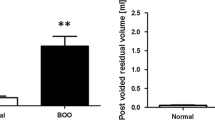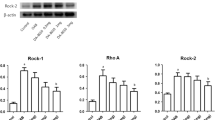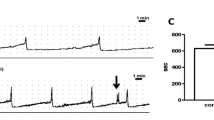Abstract
To examine the effects of intravenous and intravesical application of vibegron, a new β3-adrenoceptor (β3-AR) agonist, on bladder function in rats with oxotremorine methiodide (oxo-M: a nonselective muscarinic receptor agonist)-induced bladder overactivity. Cystometry was performed in conscious female rats with intravesical instillation of oxo-M (200 μM). In oxo-M-treated rats, vehicle or vibegron (1 and 10 mg/kg) was cumulatively applied intravenously at 30-min intervals. In other groups of rats, oxo-M + vehicle or oxo-M + vibegron (10, 100 μM, and 1 mM) was cumulatively instilled intravesically at 60-min intervals followed by intravenous application of vibegron (10 mg/kg). Expression of β3-ARs in the bladder was also evaluated using immunohistochemical staining. Intravenous application of vibegron (10 mg/kg) significantly increased bladder capacity (1.3 times) and decreased baseline, threshold, and maximal voiding pressure compared with vehicle. Next, intravesical application of vibegron (1 mM) significantly increased threshold pressure and bladder capacity (1.2 times) compared with vehicle. Combined treatments of intravesical (1 mM) and intravenous (10 mg/kg) application of vibegron induced a significantly larger degree of increases in bladder capacity (1.4 times) compared with vehicle. In addition, β3-ARs were expressed throughout the rat bladder, mainly in the urothelium. These results suggest that vibegron excreted in urine as an unchanged compound can induce the additive inhibitory effects on bladder overactivity possibly through urothelial β3-AR activation, which inhibits the afferent limb of micturition reflex rather than the efferent function as evidenced by the increases in threshold pressure and bladder capacity without affecting bladder contractile function after intravesical vibegron application.





Similar content being viewed by others
References
Birder LA, Nealen ML, Kiss S, de Groat WC, Caterina MJ, Wang E, Apodaca G, Kanai AJ (2002) Beta-adrenoceptor agonists stimulate endothelial nitric oxide synthase in rat urinary bladder urothelial cells. J Neurosci 22:8063–8070
Coelho A, Antunes-Lopes T, Gillespie J, Cruz F (2017) Beta-3 adrenergic receptor is expressed in acetylcholine-containing nerve fibers of the human urinary bladder: an immunohistochemical study. Neurourol Urodyn 36:1972–1980. https://doi.org/10.1002/nau.23224
D’ Agostino G, Maria Condino A, Calvi P (2015) Involvement of beta3-adrenoceptors in the inhibitory control of cholinergic activity in human bladder: direct evidence by [(3)H]-acetylcholine release experiments in the isolated detrusor. Eur J Pharmacol 758:115–122. https://doi.org/10.1016/j.ejphar.2015.03.074
Edmondson SD, Zhu C, Kar NF, di Salvo J, Nagabukuro H, Sacre-Salem B, Dingley K, Berger R, Goble SD, Morriello G, Harper B, Moyes CR, Shen DM, Wang L, Ball R, Fitzmaurice A, Frenkl T, Gichuru LN, Ha S, Hurley AL, Jochnowitz N, Levorse D, Mistry S, Miller RR, Ormes J, Salituro GM, Sanfiz A, Stevenson AS, Villa K, Zamlynny B, Green S, Struthers M, Weber AE (2016) Discovery of vibegron: a potent and selective beta3 adrenergic receptor agonist for the treatment of overactive bladder. J Med Chem 59:609–623. https://doi.org/10.1021/acs.jmedchem.5b01372
Furuta A, Suzuki Y, Kimura S, Koike Y, Egawa S, Yoshimura N (2016) Combination therapy with beta3 -adrenoceptor agonists and muscarinic acetylcholine receptor antagonists: efficacy in rats with bladder overactivity. Int J Urol 23:425–430. https://doi.org/10.1111/iju.13066
Igawa Y, Michel MC (2013) Pharmacological profile of beta3-adrenoceptor agonists in clinical development for the treatment of overactive bladder syndrome. Naunyn Schmiedeberg's Arch Pharmacol 386:177–183. https://doi.org/10.1007/s00210-012-0824-1
Igawa Y, Aizawa N, Michel MC (2019) beta3 -Adrenoceptors in the normal and diseased urinary bladder-what are the open questions? Br J Pharmacol 176:2525–2538. https://doi.org/10.1111/bph.14658
Ito Y, Kuraoka S, Endo S, Takahashi A, Onoue S, Yamada S (2017) Urinary excretion contributes to long-lasting blockade of bladder muscarinic receptors by Imidafenacin: effect of bilateral ureteral ligation. J Pharmacol Exp Ther 360:69–74. https://doi.org/10.1124/jpet.116.236497
Kullmann FA, Downs TR, Artim DE, Limberg BJ, Shah M, Contract D, de Groat WC, Rosenbaum JS (2011) Urothelial beta-3 adrenergic receptors in the rat bladder. Neurourol Urodyn 30:144–150. https://doi.org/10.1002/nau.20965
Limberg BJ, Andersson KE, Aura Kullmann F, Burmer G, de Groat WC, Rosenbaum JS (2010) Beta-adrenergic receptor subtype expression in myocyte and non-myocyte cells in human female bladder. Cell Tissue Res 342:295–306. https://doi.org/10.1007/s00441-010-1053-x
Matsumoto Y, Miyazato M, Furuta A, Torimoto K, Hirao Y, Chancellor MB, Yoshimura N (2010) Differential roles of M2 and M3 muscarinic receptor subtypes in modulation of bladder afferent activity in rats. Urology 75:862–867. https://doi.org/10.1016/j.urology.2009.12.013
Nomiya M, Yamaguchi O (2003) A quantitative analysis of mRNA expression of alpha 1 and beta-adrenoceptor subtypes and their functional roles in human normal and obstructed bladders. J Urol 170:649–653. https://doi.org/10.1097/01.ju.0000067621.62736.7c
Sellers D, Chess-Williams R, Michel MC (2018) Modulation of lower urinary tract smooth muscle contraction and relaxation by the urothelium. Naunyn Schmiedeberg's Arch Pharmacol 391:675–694. https://doi.org/10.1007/s00210-018-1510-8
Silva I, Costa AF, Moreira S, Ferreirinha F, Magalhães-Cardoso MT, Calejo I, Silva-Ramos M, Correia-de-Sá P (2017) Inhibition of cholinergic neurotransmission by beta3-adrenoceptors depends on adenosine release and A1-receptor activation in human and rat urinary bladders. Am J Physiol Renal Physiol 313:F388–F403. https://doi.org/10.1152/ajprenal.00392.2016
Yu W, Zacharia LC, Jackson EK, Apodaca G (2006) Adenosine receptor expression and function in bladder uroepithelium. Am J Physiol Cell Physiol 291:C254–C265. https://doi.org/10.1152/ajpcell.00025.2006
Funding
This study was supported by JSPS KAKENHI Grant Number JP18K09152.
Author information
Authors and Affiliations
Contributions
AF conceived and designed the study. TI and YK performed research. YS and TK analyzed data. AF, SE, and NY wrote the paper. All authors read and approved the manuscript. The authors declare that all data were generated in-house and that no paper mill was used.
Corresponding author
Ethics declarations
Conflict of interest
The authors declare that they have no conflict of interest.
Additional information
Publisher’s note
Springer Nature remains neutral with regard to jurisdictional claims in published maps and institutional affiliations.
Electronic supplementary material
ESM 1
(XLS 44 kb)
Rights and permissions
About this article
Cite this article
Furuta, A., Suzuki, Y., Igarashi, T. et al. Additive effects of intravenous and intravesical application of vibegron, a β3-adrenoceptor agonist, on bladder function in rats with bladder overactivity. Naunyn-Schmiedeberg's Arch Pharmacol 393, 2073–2080 (2020). https://doi.org/10.1007/s00210-020-01921-2
Received:
Accepted:
Published:
Issue Date:
DOI: https://doi.org/10.1007/s00210-020-01921-2




